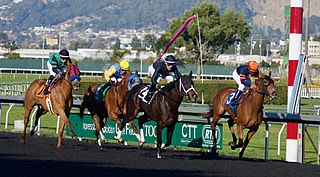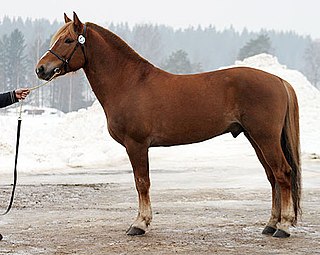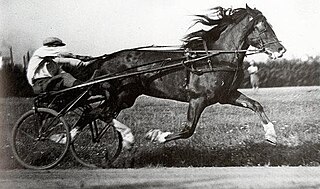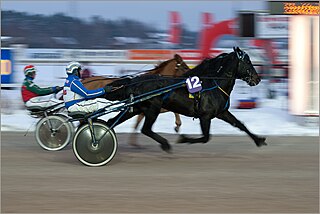
Horse racing is an equestrian performance sport, typically involving two or more horses ridden by jockeys over a set distance for competition. It is one of the most ancient of all sports, as its basic premise – to identify which of two or more horses is the fastest over a set course or distance – has been mostly unchanged since at least classical antiquity.

Harness racing is a form of horse racing in which the horses race at a specific gait. They usually pull a two-wheeled cart called a sulky, or spider, or chariot occupied by a driver. In Europe, and less frequently in Australia and New Zealand, races with jockeys riding directly on saddled trotters are also conducted.

The Standardbred is an American horse breed best known for its ability in harness racing, where members of the breed compete at either a trot or pace. Developed in North America, the Standardbred is recognized worldwide, and the breed can trace its bloodlines to 18th-century England. They are solid, well-built horses with good dispositions. In addition to harness racing, the Standardbred is used for a variety of equestrian activities, including horse shows and pleasure riding, particularly in the Midwestern and Eastern United States and in Southern Ontario.
The Little Brown Jug is a harness race for three-year-old pacing standardbred horses hosted by the Delaware County Agricultural Society since 1946 at the Delaware County Fairgrounds racetrack in Delaware, Ohio. The race takes place every year on the third Thursday after Labor Day.
The Cane Pace is a harness horse race for standardbred pacers run annually since 1955. The race was first run as the William H. Cane Futurity in 1955 at Yonkers Raceway in New York. In 1956 the race joined with the Little Brown Jug and the Messenger Stakes to become the first leg in the Triple Crown of Harness Racing for Pacers.

The Dole Gudbrandsdal, Dølahest, or Dole is a draft- and harness-type horse from Norway. The Dole Trotter is alternately considered a subtype of the Dole Gudbrandsdal and a separate breed; it is also considered a part of the coldblood trotter type. The Dole Gudbrandsdal is a small draft horse, known for its pulling power and agility, while the Dole Trotter is a smaller, faster horse used for harness racing; the two types are commonly interbred. Both types are strictly critiqued before entry into the studbook, which has over time resulted in an improvement in the breed type. The Dole is originally from the Gudbrandsdal Valley, and is probably descended in part from the Friesian horse. Over time, the breed has had Thoroughbred, Arabian, and other breeds added in, especially during the creation of the Dole Trotter in the 19th century. The first studbook was created in 1941, and the current breed association was formed in 1947. Although originally used mainly as a pack horse, today, the heavier Dole type is used mainly for agricultural purposes. The Dole Gudbrandsdal been crossed with other breeds to develop horses for harness racing and riding.

The Finnhorse or Finnish Horse is a horse breed with both riding horse and draught horse influences and characteristics, and is the only breed developed fully in Finland. In English it is sometimes called the Finnish Universal, as the Finns consider the breed capable of fulfilling all of Finland's horse needs, including agricultural and forestry work, harness racing, and riding. In 2007, the breed was declared the official national horse breed of Finland.

Harness racing, also colloquially known as trotting or the trots, is a spectator sport in Australia, with significant amounts of money wagered annually with bookmakers and the Totalisator Agency Board (TAB). In Australia there are 90 harness racing tracks, which hold over 1,900 meetings annually. There are approximately 2,900 drivers and 4,000 trainers with about 5,000 Standardbred horses foaled and registered each year.

Maori's Idol was an Australian Standardbred racehorse. He was the first Australian trotter to break two minutes with a time of 1:59.3 on 19 November 1977 at Moonee Valley. Maori's Idol became one of Australia's greatest trotters, with a record 24 successive race victories before placing third in the 1978 Melbourne Inter-Dominion Final. He is still the trotting record holder with 22 wins in a season. He was so superior to his rivals that he may have gone through his career unbeaten had he been placed to advantage by his connections.

The North Swedish Horse or Swedish: Nordsvensk Brukshäst is a Swedish breed of small heavy horse. It is closely related to the similar Dølehest breed of Norway. It was traditionally used for forestry and agricultural work. Lighter lines are bred for harness racing, and are registered in the stud-book of the Svensk Kallblodstravare.
Breed = Standartbred , Sire = Andover Hall , Grandsire = Garland Lobell , Sex = Stallion , Foaled = 2004 , Country = United States.

The French Trotter is a French breed of trotting horse bred for racing both ridden and in harness. It was bred specifically for racing in the nineteenth century, principally in Normandy in north-western France.

Järvsöfaks was a Swedish trotter. He held the current coldblood trotter's world record in wins, consecutive wins (42), and the coldblood trotter world record time, 1:17.9 per kilometre. His bloodlines included both Swedish and Norwegian coldblood trotters.

Reipas was a successful Finnish trotter. He was a Finnhorse gelding, and the first Finnish horse to earn over one million marks in one season.

Eri-Aaroni 3423 Valio was liver chestnut stallion who was a Ravikuningas title winner in harness racing and a very influential Finnhorse sire.

The Scandinavian Coldblood Trotter consists of two closely related and interconnected breeds of trotting horse: the Norsk Kaldblodstraver or Norwegian Coldblood Trotter and the Svensk Kallblodstravare, the Swedish Coldblood Trotter or North Swedish Trotter. Coldblood trotters are the result of cross-breeding native coldblooded farm horses – in Norway the Dølehest, in Sweden the North Swedish Horse – with lighter and faster horses. Although the Norwegian and Swedish coldblood trotters are substantially considered a single breed, two national stud-books are maintained, and registration requirements differ in some respects between the two countries.

Eureka Downs was an American horse racing track located near U.S. Route 54 in Eureka, Greenwood County, Kansas. Run by the Greenwood County Fair Association, the facility hosted Standardbred harness racing, American Quarter Horse, and Thoroughbred flat racing events.
Horse racing in the United States dates back to 1665, which saw the establishment of the Newmarket course in Salisbury, New York, a section of what is now known as the Hempstead Plains of Long Island, New York. This first racing meet in North America was supervised by New York's colonial governor, Richard Nicolls. The area is now occupied by the present Nassau County, New York, region of Greater Westbury and East Garden City.
Harness racing, is a popular sport in Sweden, with significant amounts of money wagered annually. In Sweden there are 33 harness racing tracks, which hold over 850 meetings annually. There are approximately 3,000 drivers and 6,000 trainers with about 18,000 horses in training.















